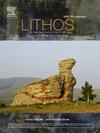Genesis and geodynamic setting of granitoids at the giant Siahdik S1 porphyry CuAu deposit, Chagai belt, Western Pakistan
IF 2.9
2区 地球科学
Q2 GEOCHEMISTRY & GEOPHYSICS
引用次数: 0
Abstract
The Siahdik deposit is a newly discovered giant porphyry Cu![]() Au deposit (>8 Mt. Cu) in the western Chagai magmatic belt, Pakistan. The deposit includes a western (3.27 Mt. at 0.32 % Cu and 0.12 g/t Au) and an eastern (4.84 Mt. at 0.48 % Cu and 0.10 g/t Au) mineralization center. The origin and tectonic settings of granitoids at this deposit is not clear, in particular as different magmatic units show strong mineralization. Our new age data show that the western porphyry center includes pre-mineralization biotite granites (42.7 ± 0.4 Ma), ore-bearing granodiorites (40.6 ± 0.5 Ma), ore-forming quartz-diorite porphyries (24.4 ± 0.2 Ma), and post-mineralization andesite porphyries (24.0 ± 0.3 Ma). Eight molybdenite samples from mineralized granodiorites and quartz-diorite porphyries yield Re
Au deposit (>8 Mt. Cu) in the western Chagai magmatic belt, Pakistan. The deposit includes a western (3.27 Mt. at 0.32 % Cu and 0.12 g/t Au) and an eastern (4.84 Mt. at 0.48 % Cu and 0.10 g/t Au) mineralization center. The origin and tectonic settings of granitoids at this deposit is not clear, in particular as different magmatic units show strong mineralization. Our new age data show that the western porphyry center includes pre-mineralization biotite granites (42.7 ± 0.4 Ma), ore-bearing granodiorites (40.6 ± 0.5 Ma), ore-forming quartz-diorite porphyries (24.4 ± 0.2 Ma), and post-mineralization andesite porphyries (24.0 ± 0.3 Ma). Eight molybdenite samples from mineralized granodiorites and quartz-diorite porphyries yield Re![]() Os model ages of 24.8–25.2 Ma with a weighted average age of 25.0 ± 0.3 Ma, implying that all mineralization belongs to the younger group of magmatic rocks. The Middle Eocene biotite granites and granodiorites are high-K calc-alkaline series rocks, whereas the Late Oligocene quartz-diorite porphyries and andesite porphyries are medium-K calc-alkaline series rocks with high Sr/Y ratios. These granitic rocks are enriched in the large ion lithophile elements Rb, Ba, and K and light rare earth elements and depleted in heavy rare earth elements and the high-field strength elements Nb, Ta, and Ti. They have relatively low (87Sr/86Sr)i values (0.70407–0.70575), positive εNd(t) (1.4 to 3.7) and εHf(t) values (+10.7 to +21.4), and mantle-like zircon δ18O values (+4.09 to +6.48), typical for magmas derived from a relatively enriched mantle source that was modified by components from the subducted slab. The compositions of zircon crystals from the granitoids of the deposit indicate that the parental magmas – in particular the fertile quartz-diorite porphyries – were relatively oxidized. These geochemical and isotopic features, along with the absence of inherited zircon grains suggest that the parental magmas of the Late Oligocene porphyry Cu
Os model ages of 24.8–25.2 Ma with a weighted average age of 25.0 ± 0.3 Ma, implying that all mineralization belongs to the younger group of magmatic rocks. The Middle Eocene biotite granites and granodiorites are high-K calc-alkaline series rocks, whereas the Late Oligocene quartz-diorite porphyries and andesite porphyries are medium-K calc-alkaline series rocks with high Sr/Y ratios. These granitic rocks are enriched in the large ion lithophile elements Rb, Ba, and K and light rare earth elements and depleted in heavy rare earth elements and the high-field strength elements Nb, Ta, and Ti. They have relatively low (87Sr/86Sr)i values (0.70407–0.70575), positive εNd(t) (1.4 to 3.7) and εHf(t) values (+10.7 to +21.4), and mantle-like zircon δ18O values (+4.09 to +6.48), typical for magmas derived from a relatively enriched mantle source that was modified by components from the subducted slab. The compositions of zircon crystals from the granitoids of the deposit indicate that the parental magmas – in particular the fertile quartz-diorite porphyries – were relatively oxidized. These geochemical and isotopic features, along with the absence of inherited zircon grains suggest that the parental magmas of the Late Oligocene porphyry Cu![]() Au deposit most probably were derived from the partial melting of the metasomatized mantle wedge, with minor contributions from crust materials. The deposit formed in a continental arc setting during northward subduction of the Neo-Tethys. The studied porphyry Cu
Au deposit most probably were derived from the partial melting of the metasomatized mantle wedge, with minor contributions from crust materials. The deposit formed in a continental arc setting during northward subduction of the Neo-Tethys. The studied porphyry Cu![]() Au deposit is related to a highly oxidized, H2O- and volatile-rich magmatic system.
Au deposit is related to a highly oxidized, H2O- and volatile-rich magmatic system.

求助全文
约1分钟内获得全文
求助全文
来源期刊

Lithos
地学-地球化学与地球物理
CiteScore
6.80
自引率
11.40%
发文量
286
审稿时长
3.5 months
期刊介绍:
Lithos publishes original research papers on the petrology, geochemistry and petrogenesis of igneous and metamorphic rocks. Papers on mineralogy/mineral physics related to petrology and petrogenetic problems are also welcomed.
 求助内容:
求助内容: 应助结果提醒方式:
应助结果提醒方式:


